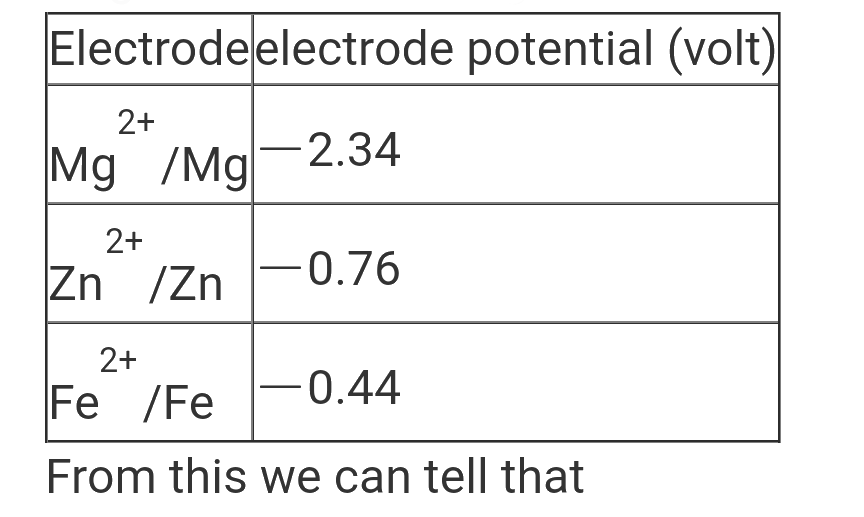The standard reduction potential for silver electrode is +0.80 V. It is connected to a standard hydrogen electrode to make a galvanic cell. State whether silver electrode will act as anode or cathode.
To determine whether the silver electrode acts as an anode or a cathode when connected to a standard hydrogen electrode (SHE), we can follow these steps:
1. Identify Standard Reduction Potentials:
- The standard reduction potential for the silver electrode (Ag⁺/Ag) is given as +0.80 V.
- The standard reduction potential for the standard hydrogen electrode (SHE) is defined as 0.00 V.
2. Compare the Standard Reduction Potentials:
- Since the standard reduction potential of silver (+0.80 V) is greater than that of SHE (0.00 V), silver has a greater tendency to gain electrons (be reduced) compared to hydrogen.
3. Determine the Role of Each Electrode:
- In a galvanic cell, the electrode with the higher reduction potential acts as the cathode (where reduction occurs), and the electrode with the lower reduction potential acts as the anode (where oxidation occurs).
- Therefore, since silver has a higher reduction potential, it will act as the cathode.
4. Conclusion:
- The silver electrode will act as the cathode, and the standard hydrogen electrode will act as the anode in this galvanic cell.
Final Answer:
The silver electrode acts as the cathode, while the standard hydrogen electrode acts as the anode.
---
- The standard reduction potential for the silver electrode (Ag⁺/Ag) is given as +0.80 V.
- The standard reduction potential for the standard hydrogen electrode (SHE) is defined as 0.00 V.
- Since the standard reduction potential of silver (+0.80 V) is greater than that of SHE (0.00 V), silver has a greater tendency to gain electrons (be reduced) compared to hydrogen.
- In a galvanic cell, the electrode with the higher reduction potential acts as the cathode (where reduction occurs), and the electrode with the lower reduction potential acts as the anode (where oxidation occurs).
- Therefore, since silver has a higher reduction potential, it will act as the cathode.
- The silver electrode will act as the cathode, and the standard hydrogen electrode will act as the anode in this galvanic cell.
The silver electrode acts as the cathode, while the standard hydrogen electrode acts as the anode.
Topper's Solved these Questions
- REDOX REACTIONS (OXIDATION AND REDUCTION)BOOK - ICSECHAPTER - REDOX REACTIONS (OXIDATION AND REDUCTION)EXERCISE - SHORT ANSWER TYPE QUESTIONS
12 Videos
- REDOX REACTIONS (OXIDATION AND REDUCTION)BOOK - ICSECHAPTER - REDOX REACTIONS (OXIDATION AND REDUCTION)EXERCISE - ESSAY (LONG ANSWER) TYPE QUESTIONS
8 Videos
- REDOX REACTIONS (OXIDATION AND REDUCTION)BOOK - ICSECHAPTER - REDOX REACTIONS (OXIDATION AND REDUCTION)EXERCISE - REVIEW EXERCISES
37 Videos
- ORGANIC CHEMISTRY : SOME BASIC PRINCIPLES AND TECHNIQUES BOOK - ICSECHAPTER - ORGANIC CHEMISTRY : SOME BASIC PRINCIPLES AND TECHNIQUES EXERCISE - NCERT TEXT-BOOK EXERCISES (WITH HINTS AND SOLUTIONS )
72 Videos
- SAMPLE QUESTION PAPERBOOK - ICSECHAPTER - SAMPLE QUESTION PAPEREXERCISE - Question
69 Videos
Similar Questions
Knowledge Check
A standard hydrogen electrode has zero electrode potential because :
Ahydrogen can be most easily oxidisedBhydrogen has only one electronCthe electrode potential is assumed to be zeroDhydrogen is the lightest element.
The standard EMF of decinormal calomel electrode is 0.268V. The EMF is
View SolutionThe standard reduction potential at 298 K for single electrodes are given below.l

From this we can tell that
View SolutionWhich of the following electrodes will act as anodes, which connected to Standard Hydrogen Electrode?
View SolutionThe half cell reduction potential of a hydrogen electrode at pH=5 will be :
View SolutionThe standard oxidation potential of Ni/Ni+2 electrode is 0.236 V. If this electrode is combined with a hydrogen electrode in acid solution, at what pH of the solution will the measured emf be zero at 25∘C? Assume[Ni+2]=1M
View SolutionA standard hydrogen electrode has zero electrode potential because :
View SolutionAt what pH the potential of Hydrogen electrode will be 0.059 V?
View Solution
